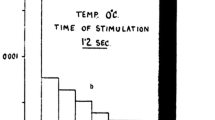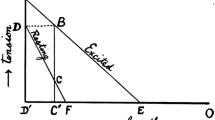Abstract
Although muscle contraction is one of the principal themes of biological research, the exact mechanism whereby the chemical free energy of ATP hydrolysis is converted into mechanical work remains elusive. The high thermodynamic efficiency of the process, above all, is difficult to explain on the basis of present theories. A model of the elementary effect in muscle contraction is proposed which aims at high thermodynamic efficiency based on an approximate equilibrium between chemical and mechanical forces throughout the transfer of free energy. The experimental results described in the literature support the assumption that chemimechanic equilibrium is approximated by a free energy transfer system based on the binding of divalent metal ions to the myosin light chains. Muscle contraction demonstrated without light chains is expected to proceed with a considerably lower efficiency. Free energy transfer systems based on the binding of ions to proteins seem to be widespread in the cell. By establishing an approximate chemimechanic equilibrium, they could facilitate biological reactions considerably and save large amounts of free energy. The concept of chemimechanic equilibrium is seen as a supplementation to the concept of chemiosmotic equilibrium introduced for the membrane transport by P. Mitchell.
Similar content being viewed by others
References
Huxley, H. E.: Science164, 1356 (1969)
Eisenberg, E., Hill, T. L.: Science227, 999 (1985)
Geeves, M. A.: Biochem. J.274, 1 (1991)
Woledge, R. C.: Nature334, 655 (1988)
Simmons, R. M., Szent-Gyorgyi, A. G.: Nature273, 62 (1978); 286, 626 (1980)
Huxley, A. F., Simmons, R. M.: ibid.233, 533 (1971); Huxley, A. F.: J. Physiol.243, 1 (1974)
Brenner, B., Schoenberg, M., Chalovich, J. M., Greene, L. E., Eisenberg, E.: Proc. Natl. Acad. Sci. USA79, 7288 (1982)
Matsuda, T., Podolsky, R. J.: ibid.81, 2364 (1984); Brenner, B., Yu, L. C., Podolsky, R. J.: Biophys. J.46, 299 (1984)
Winkelmann, D. A., Almeda, S., Vibert, P., Cohen, C.: Nature307, 758 (1984)
Kwon, H., Goodwin, E. B., Nyitray, L., Berliner, E., O'Neall-Hennessy, E., Melandri, F. D., Szent-Gyorgyi, A. G.: Proc. Natl. Acad. Sci. USA87, 4771 (1990)
Bagshaw, C. R., Kendrick-Jones, J.: J. Mol. Biol.130, 317 (1979)
Reinach, F. C., Nagai, K., Kendrick-Jones, J.: Nature322, 80 (1986)
In a preliminary publication on the free energy transfer by myosin light chains [E. W. Becker, Naturwissenschaften77, 478 (1990)], the arguments were based mainly on the similarity between the regulatory light chain and the regulatory protein calmodulin. So, a predominance of calcium in the free energy transfer process was assumed. The potential advantages of a free energy transfer system based on ion binding to myosin light chains, of course, do not depend on the special ions actually involved
Cox, J. A., Comte, M., Mamar-Bachi, A., Milos, M., Schaer, J.-J., in: Calcium and Calcium Binding Proteins, p. 141 (Gerday, Ch., Gilles, R., Bolis, L., eds.). Heidelberg: Springer 1988
Kataoka, M., Head, J. F., Seaton, B. A., Engelman, D. M.: Proc. Natl. Acad. Sci. USA86, 6944 (1989)
The degree of cooperativity, of course, will depend on the number of exchangeable ions per light chain, which, with the knowledge at hand, can be determined only arbitrarily. The two-headed construction of the myosin molecule, on the other hand, can be expected to help in the cooperativity of ion binding in any case
Hardwicke, P. M. D., Wallimann, T., Szent-Gyorgyi, A. G.: Nature301, 478 (1983)
Amos, L. A., Huxley, H. E., Holmes, K. C., Goody, R. S., Taylor, K. A.: ibid.299, 467 (1982)
Walker, M., Trinick, J.: J. Mol. Biol.208, 469 (1989)
Cooke, R.: Nature294, 570 (1981)
Yanagida, T.: J. Mol. Biol.146, 539 (1981)
Tokunaga, M., Sutoh, K., Toyoshima, C., Wakabayashi, T.: Nature329, 635 (1987)
Yamamoto, K.: J. Mol. Biol.209, 703 (1989)
Yanagida, T., Arata, T., Oosawa, F.: Nature316, 366 (1985)
Fenn, W. O.: J. Physiol. London58, 373 (1924)
Curmi, P. M. G., Stone, D. B., Schneider, D. K., Spudich, J. A., Mendelson, R. A.: J. Mol. Biol.203, 781 (1988)
Craig, R., Greene, L. E., Eisenberg, E.: Proc. Natl. Acad. Sci. USA82, 3247 (1985)
Squire, J.: Nature335, 590 (1988)
Brenner, B.: Proc. Natl. Acad. Sci. USA85, 3265 (1988)
Chacko, S., Conti, M. A., Adelstein, R. S.: ibid.74, 129 (1977)
Kendrick-Jones, J., Szentkiralyi, E. M., Szent-Gyorgyi, A. G.: J. Mol. Biol.104, 747 (1976)
Becker, E. W.: Naturwissenschaften77, 176 (1990)
Becker, E. W.: ibid.77, 436 (1990)
Mitchell, P.: Nature191, 144 (1961)
Author information
Authors and Affiliations
Rights and permissions
About this article
Cite this article
Becker, E.W. Efficiency of muscle contraction. The chemimechanic equilibrium. Naturwissenschaften 78, 445–449 (1991). https://doi.org/10.1007/BF01134378
Issue Date:
DOI: https://doi.org/10.1007/BF01134378




